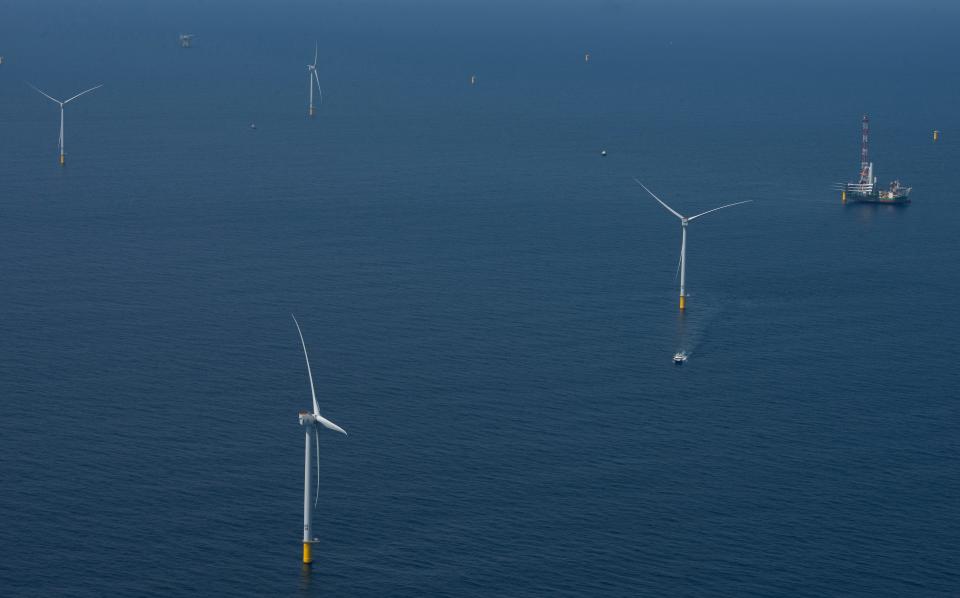'Three large blade pieces.' Vineyard Wind wind turbine blade snaps. Search underway
After part of a blade on one of the Vineyard Wind 1 offshore turbines broke off and fell into the ocean over the weekend, the company put two teams to work on Tuesday to seek out and recover any debris coming ashore on southern-facing beaches on Nantucket.
"The blade experienced a breakage approximately 20 meters out from the root," company spokesman Craig Gilvarg said on Tuesday afternoon.
The turbine the blade was attached to was in its commissioning phase and was still undergoing testing. A large length of the blade remains affixed to the turbine and has not fallen into the water, he reported.
According to the company, the damage happened on Saturday evening. No employees, contractors or fishing vessels were in the vicinity of the turbine at the time.
Monitoring for floating debris
The company, Gilvarg said Tuesday, "deployed service vessels immediately to recover three large blade pieces from the ocean." The offshore area continues to be monitored for any floating debris with aerial overflights and vessel patrols.
"As part of its permitting, Vineyard Wind has detailed plans to guide its response to incidents such as this. Following those protocols, Vineyard Wind established a safety perimeter, and worked with the U.S. Coast Guard to issue notice to mariners," the company explained in a statement issued just before 4 p.m. Monday.
The company's response has included reaching out to officials on Nantucket to inform them of the presence of debris and recovery efforts on the southern-facing beaches of the island.
Non-toxic fiberglass fragments
Two teams of four people began surveying the Nantucket shore on Tuesday morning, and will continue that effort each morning and evening for several days — specifically, they will visit Miacomet Beach and the southeastern tip of Nantucket, including Nobadeer Beach, Madequecham Beach, Pebble Beach, Tom Nevers Beach, Low Beach, and Sconset Beach, or other areas where debris may wash ashore.
According to the company, "the debris consists of non-toxic fiberglass fragments ranging in size from small pieces to larger sections, typically green or white in color."
That debris is expected to be pieces of 1 square foot or less.
"Although the fiberglass fragments are not hazardous to people or the environment, Vineyard Wind recommends that only its employees or contractors collect and remove the debris," the company noted in a follow up release issued Tuesday morning.

GE undertaking an investigation
General Electric, which manufactures the project’s Haliade-X turbines and blades is now conducting an analysis of what happened.
"The cause of the breakage is unknown at this time," Gilvarg said. "GE, as the project’s turbine and blade manufacturer and installation contractor, will now be conducting the analysis into the root cause of the incident."
As that analysis takes place, the company said it "remains focused on ensuring the safety of personnel and mariners in the offshore area, and continues to work with the U.S. Coast Guard to maintain a safety zone of 500 meters around the impacted turbine offshore."
Almost the length of a football field
The turbines and blades are monumental in size, each including a monopile anchoring it to the seafloor, a transitional piece at the surface, then a tower topped by a nacelle and three blades. The blades are 107 meters long, or almost the length of a football field including the end zones. The height of each turbine is about the same as three Statues of Liberty stacked up (about 850 feet), from blade tip to the water's surface.
According to the U.S. Office of Energy Efficiency and Renewable Energy, that scale is typical for offshore wind turbines. The greater heights and longer blades allow each turbine to create more energy more efficiently. Therefore fewer turbines are needed to produce the same power that shorter turbines with shorter blades would generate.
At least 10 turbines are capable of producing power now
Vineyard Wind, a joint venture of Avangrid and Copenhagen Infrastructure Partners that's touted as the nation's first commercial-scale offshore wind farm, is under construction in the shallow waters of the outer continental shelf 14 miles south of the Vineyard. The consistently strong wind patterns and shallow depth there make it an ideal location.
The 806-megawatt project will eventually have 62 turbines in operation — enough to power more than 400,000 homes and businesses in Massachusetts, according to the company. As of June 24, 20 turbines were installed, according to the company. Ten of those had completed commissioning procedures and were operational, offering a capacity to produce about 136 megawatts, or enough to power 64,000 homes and businesses, the company said.
How to report debris
If debris is found by members of the public, property owners, or town officials, they are advised to immediately contact: Ian Campbell at 781-983-8943, or by email at icampbell@vineyardwind.com
Reports of debris can also be sent directly to the cleanup contractor at tinyurl.com/reportVWdebris
Heather McCarron writes about climate change, environment, energy, science and the natural world. Reach her at hmccarron@capecodonline.com, or follow her on X @HMcCarron_CCT
The Cape Cod Times is providing this coverage for free as a public service. Please take a moment to support local journalism by subscribing.
This article originally appeared on Cape Cod Times: Offshore wind turbine blade broke off south of Vineyard. What we know.

